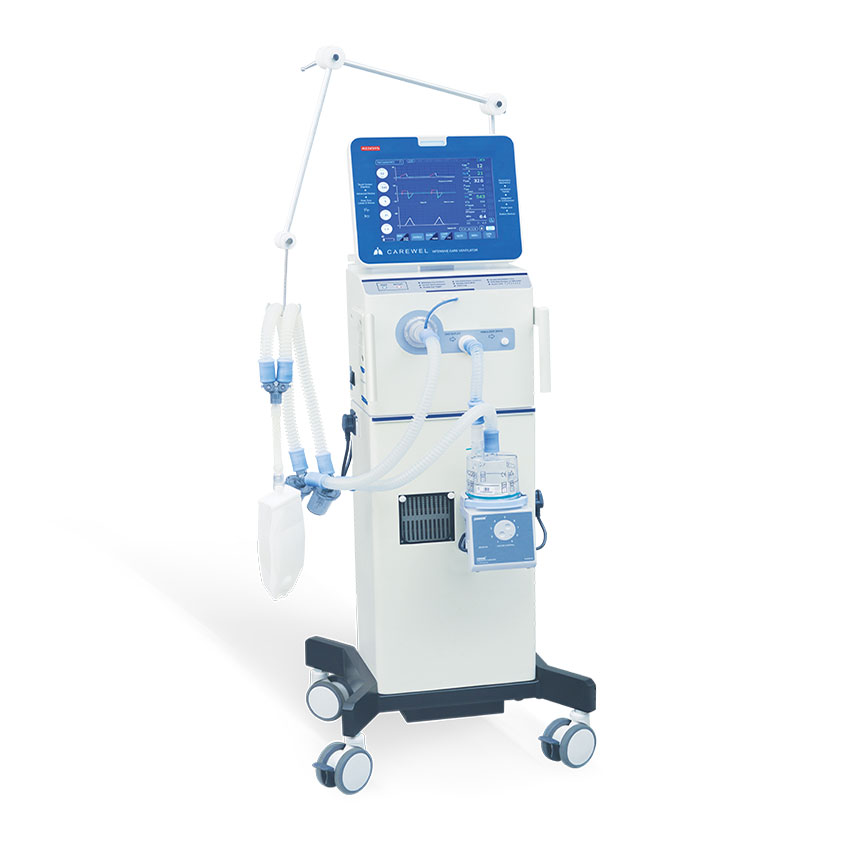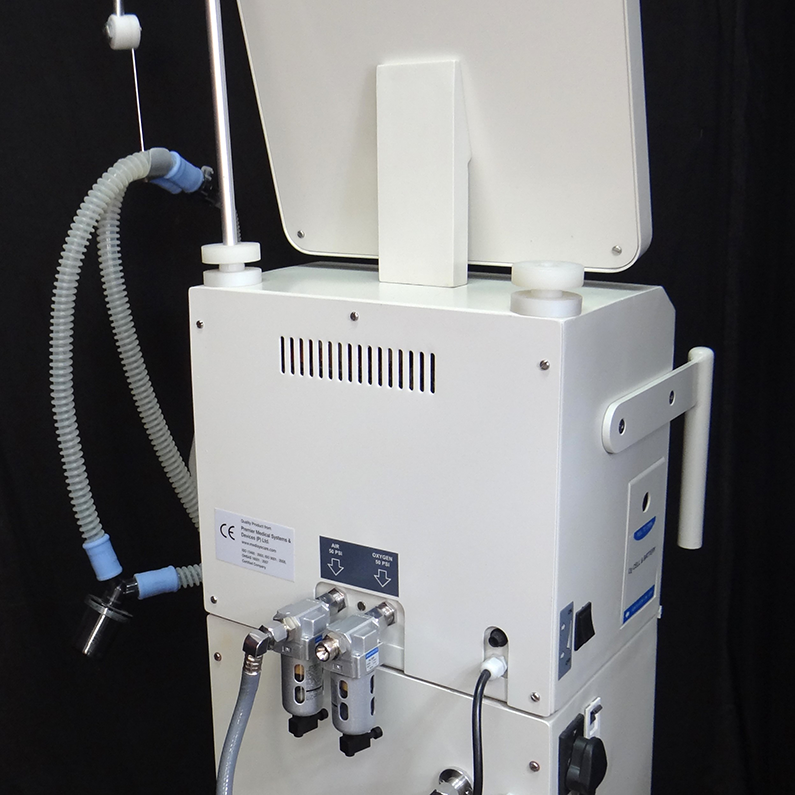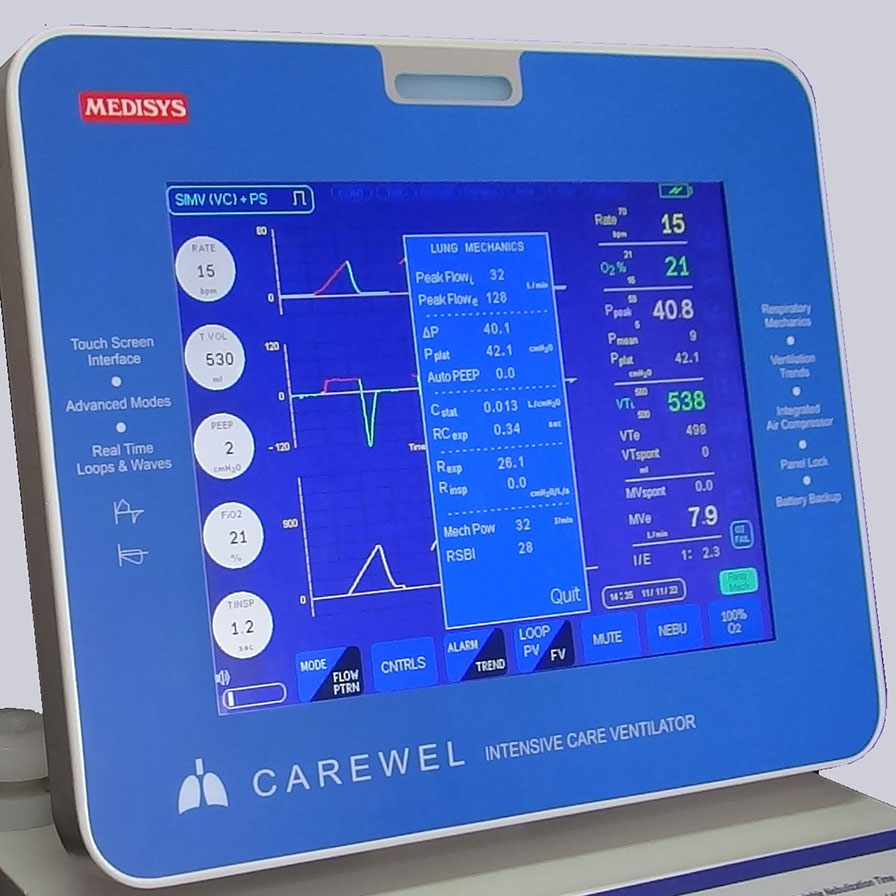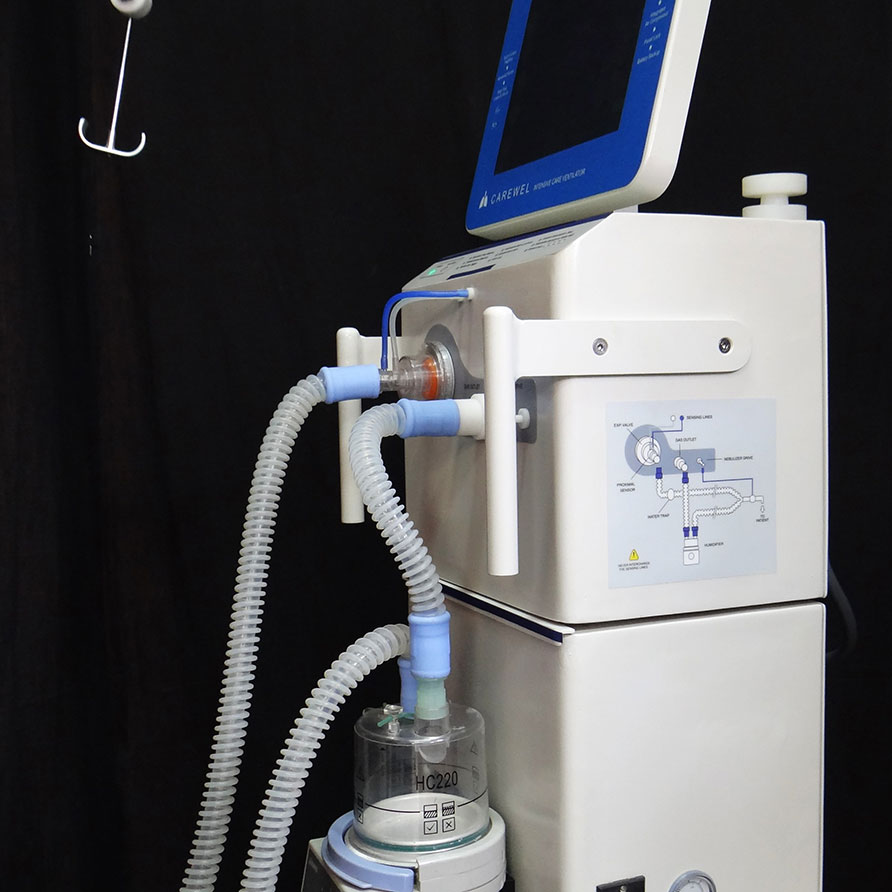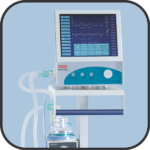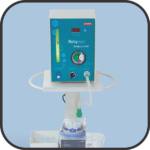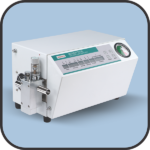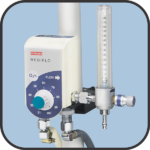Carewel
Critical Care Ventilator
The ventilator has been designed and developed with extensive research for acute management of respiratory care. The touch operated control panel offers ease of operation.
While the adaptive modes offer better patient-ventilator synchrony, the Trends and the Respiratory Mechanics help for adequate and effective ventilation in critical situations.
The Respiratory Mechanics is based on very powerful and effective software which is formulated with “Least Square Fitting’ (LSF) technique. It provides several data pertaining to ventilation even without using the manoeuvres of Inspiratory Hold. The data is very extensive that would help better respiratory management.
The clinical air compressor built in the system uses device based on Peltier Effect for removal of moisture. The ventilator has adequate battery back-up for 6 hours.
Features
It is built using Projected Capacitive Touch panel technology that provides high precision and fast response time for touch detection. It gives much comfort interfacing with the touch panel.
The screen layout is very intuitive for easy handling of the device.
The ventilator offers several control and support modes along with their combinations. There are distinct modes useful for weaning off the patient.
There is a choice of interactive mode also where control and support modes can be switched automatically. This is helpful when the patient has insufficient spontaneous activity and immediate switching to corresponding control mode is desired to sustain life.
It also provides non-invasive ventilation NIV as well. At times it is preferred to avoid complications associated with invasive ventilation.
To sum up
-
PSV can substantially reduce the Work of breathing (WOB)
-
PRVC automatically ventilate at minimum pressure possible.
-
SIMV provides better ventilator-patient synchrony and is a useful tool for weaning.
-
VS modulates the pressure of PSV to achieve the target volume, the goal prescribed by the operator.
-
2-PAP is an invasive bi-level pressure control mode where patient breaths freely in both the pressure levels. The frequency of mandatory cycling between the pressure levels is as set by the operator. It synchronizes with the patient if the breathing effort falls within the synchronization window. It supports spontaneous breathing with reduced WOB.
-
NIV is a bi-level pressure control mode, purely for mask ventilation. The cycling between the two levels is patient controlled. It essentially avoids the complications of invasive ventilation and is reported to have shorter period of hospitalization.
-
APRV is effective for ARDS / acute lung injury cases.
Simultaneous display of three waves have been provided. The display is on real time basis. It shows the pressure, flow and volume curves plotted against time.
The respiratory mechanics provide several critical data needed for better respiratory management. The data may be extracted using the manoeuvre of Inspiratory Hold.
If no such manoeuvre is applied, very closer estimated data can be availed using the powerful software instead. The software uses least square fitting (LSF) technique to arrive at the vital data.
The respiratory mechanics provides parameters like :
Inspiratory Peak-flow, Expiratory Peak-flow, Driving Pressure, Plateau Pressure, Auto-PEEP, Static Compliance, Inspiratory & Expiratory Resistances, Expiratory R*C, Pressure-time product (PTP), Mechanical Power imposed, and Rapid Shallow Breathing Index (RSBI).
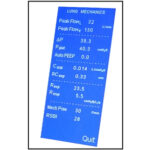
Manoeuvre uses extended inspiratory hold when no flow is added to the lungs. The expiratory valve is kept closed for the duration.
The idea is to allow distribution of tidal volume throughout the lung space during the hold and to measure the alveolar pressure after the distribution. End distribution, the proximal pressure and the alveolar pressure tend to equalize. The proximal pressure would then give the measure of the alveolar pressure which is termed as the plateau pressure. The plateau pressure is an important data for lung mechanics.
Although this manoeuvre would give the correct measure of Plateau pressure, at times it may not be preferred to hold the inspiration. The ventilator uses the inbuilt software to effectively calculate the different parameters in such situations.
The ventilator allows considering different duration of non-breathing state for the purpose of deciding a patient to be Apnic. Corrective measures like apnea back up are then applied. As a normal practice, longer apnea time is considered for adults. It helps the operator to apply for better ventilatory management.
Different flow patterns are available for selection. The Square Wave maintains a constant flow throughout the inspiration of mechanical breath. In Decelerating Flow pattern, the flow diminishes progressively. The speed of flow reduction may be set in the form of % for slow or rapid decay of flow. In Accelerating Flow, it increases progressively instead from lower to higher flow rate. The speed of rise can be set in desired % by sliding at the touch panel.
The clinical use of different flow pattern is well known. The operator has the wide choice to consider to suit the specific requirement. The cases of Pneumothorax, Atelectasis, COPD, or ARDS may be better treated using these variations.
Trends give a fair idea of patient’s recovery due to ventilation strategy followed. Three out of seven parameters may be chosen. The selected parameters are then plotted against time and displayed simultaneously. The Time may be set from 6 hours to 10 days. The operator may also opt for past record saved earlier or view the graphs live.
The seven parameters available are PEEP, Peak Pressure, Plateau Pressure, PSV, Exp. Minute Volume, Spontaneous Minute Volume and Rate
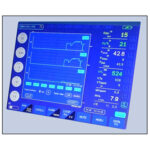
It has an important role in PSV mode. It sets when to withdraw the raised support pressure of PSV vis-à-vis the fulfillment of demand.
The demand flow, once initiated, decays progressively as the demand is met. In other words, the flow varies from 100% to 0% when the demand is satisfied completely. But considering the comfort to the patient, the demand flow is withdrawn prematurely without satisfying the demand completely.
However, if withdrawn too early, the demand would be too less satisfied. The withdrawal thus needs to be set judiciously to avoid asynchrony with the patient.
Higher ETS would withdraw the raised pressure earlier than the lower ETS would do.
The duration for nebulization may be set by the operator. The nebulization stops automatically after the set time. It helps the operator in his busy schedule.
Instant 100% oxygen may availed by operating the touch panel at the specific point. But the operator may need to deactivate the facility after some time. It would be convenient to set the duration instead. The durations from 2 to 10 minutes are available.
It protects against accidental or unwarranted tampering in the touch panel. If no activity of setting is detected beyond 60 seconds, the panel becomes locked automatically. To deactivate, the LOCK symbol is to be touched momentarily.
The display is dimmed automatically if no action on the panel is detected over 2 minutes. It avoids disturbances due to unwanted illuminations at night. More importantly, it saves battery power and increases the backup considerably. The usual brightness is restored on touching the panel again.
The sound of alarms may sometimes become irritating and may disturb the patients as well. The ventilator provides for adjusting the loudness of alarm to suit the requirement. The sound can be adjusted from 10 to 50 dB approximately.
| Screen 12.1″ TFT Touch interface |
| Modes VC, PC, PRVC, PS, VS, SIMV + PS APRV, NIV & Auto-shift |
| Flow pattrn SQ, Accelerating & Deaccelerating |
| Loops. PV & FT |
| Curves PT, FT & VT |
| Tidal Vol 50 to 1500 ml |
| Rate 1 to 50 Breaths/min |
| Insp Time 0.3 to 3 sec |
| Sensitivity 1 to 9 cmH2O below peep or 1 to 15 LPM |
| APRV 5 to 40 cm H2O @ 1 to 50 BPM |
| PEEP 0 to 30 cm H2O |
| PCV 0 to 40 cm H2O |
| PSV 0 to 30 cm H2O |
| Exp Trg Sens 5 to 85% of peak flow |
| 2 PAP IPAP : 5 to 40 cm H2O 2 EPAP : 0 to 30 cm H2O @ 1 to 50 2 BPM & Insp Time of 0.3 to 3 sec. |
| Apnea Time 4 to 20 sec |
| Panel lock After 2 mins |
| Dimming After 1 min |
| Battery backup 4 hours |
| Patient data Monitored |
| Resp. Mech. By Insp Hold manoeuvre/LSF method Parameters: – Peak Insp & Exp Flow – Delta P – Plateu pressure – Auto PEEP – Static Compliance – Exp Time constant – Resistance – Mech Power delivered – Rapid Shallow Breathing Index |
| Power Input 200 to 240 VAC, 50 Hz |

